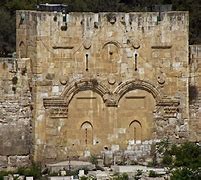PART II: Some History of Zion, Jerusalem’s Temple Mount, and Jerusalem’s Church of the Holy Sepulchre
THE ANCIENT PAST: 13th century BCE to 1750 BCE
At the end of the 13th century BCE—which was the beginning of the Iron age—all these powers suddenly collapsed; centralized state systems imploded; and the region was hit by a devastating famine. Moreover, cities all around the eastern Mediterranean were sacked within a span of a few decades by assorted raiders known as the Sea Peoples, a confederation of both local and foreign warriors and tribes that settled in the Levant after the Late Bronze Age collapse. The Hittite empire was destroyed and its capital was razed to the ground. Egypt repelled its attackers with only a major effort, and over the next century shrank to its territorial core, its central authority permanently weakened. Powerful city-states were completely destroyed, abandoned, and largely forgotten.
Despite the dim outlook and tumultuous beginning of the Iron Age, it was a period in which a number of technological innovations spread: such as iron working and the Phoenician alphabet, developed by the Phoenicians around the 11th century BCE from the Old Canaanite script, possibly a hybrid of Hieroglyphs, Cuneiform, and the mysterious Byblos syllabary. The massive destruc-tion at the end of the Bronze Age left a number of tiny kingdoms and city-states behind.
In the 12th century BCE, most of interior Syria as well as Babylonia and Upper Mesopo-tamia, was overrun by Aramaeans, Chaldeans, Arabs, and Suteans. Further west, the Levantine coast was settled by the incoming Sea Peoples, most notably by the Philistines around the modern Gaza Strip. Unlike most of Syria and Southern Levant, Phoenician city-states in Canaan managed to escape the destruction that ensued in the Late Bronze age collapse, and developed into big commercial powers. Phoenician centers of Byblos, Tyre, Sidon, and Arwad, actually flourished.
As a matter of comparison to the Hebrew Bible peoples; Abraham, Sarah, Isaac, Rebecca, Jacob, Leah, and Rachel, Joseph and his eleven brothers were recorded at ~1600 BCE; the 350 years of Egyptian bondage ~1400 BCE; Moses, Aaron, Miriam, the Exodus and wandering in the wilderness for 40-50 years, the Covenant and Commandments, arrival in Canaan ~1200 BCE; entrance into and settling in Canaan, Joshua, Deborah, Gideon, Samson, the Period of the Judges, and the loose federation of the 12 tribes ~1200 BCE for about 200 years; United Kingdom, Saul, David, Solomon, Samuel, and Nathan ~1000-800 BCE; Northern Kingdom defeated by the Assyrians ~721 BCE, and the Southern Kingdom defeated by Babylon ~586 BCE; Babylon captivity followed by return to Jerusalem, rebuilding the city, Ezra, Nehemiah ~200 BCE; Greeks, Egyptians, and Syrians, ~200-100 BCE, for about 100 years; Maccabeans ~100 years, Jesus ~30 years, Romans ~500 years partially covered in New Testament. From ~100 BCE-500 BCE.
Two new groups appeared in the southern Levant during the early Iron Age: the Philistines–a group of Aegean immigrants who arrived in the southern shore of Canaan around 1175 BCE and settled there–and the Israelites, who gradually established many small communities that dotted the central highlands. The Israelites’ exodus from Egypt and conquest of Canaan as described in the Hebrew Bible are nearly universally disputed by modern scholarship—including investigators from Egypt and Israel. The best current accumulation of evidence holds that the Israelites and their culture diverged from the Canaanite peoples and their cultures through the development of a unique monolatristic [lit. ”single”, and “worship”–the belief in the existence of many gods, but with the consistent worship of only one deity]—and later monotheistic—religion centered on the national tribal god Yahweh [an attempt to give the god–whose name cannot be spoken–somewhat of a pronounceable name or title without actually saying his name. The compendium of well researched evidence in that regard is too huge even to summarize here.
The 10th and 9th centuries BCE saw the emergence of several territorial kingdoms in the southern Levant. Two Israelite kingdoms emerged: the Kingdom of Israel, which ruled over the areas of Samaria, Galilee, Sharon and parts of Transjordan, and had its capital for the most of its history in the city of Samaria, and the Kingdom of Judah, which controlled the Judaean Mountains, most of the Shfela, and the northern Naqab, and had its capital in Jerusalem. Three Canaanite kingdoms—Moab, Ammon, and Edom—began to arise in Transjordan at about the same period.
The urban development of Canaan lagged considerably behind that of Egypt and Mesopotamia and even that of Syria, where from 3,500 BCE a sizable city developed at Hamoukar. This city–which was conquered, probably by people coming from the Southern Iraqi city of Uruk–saw the first connections between Syria and Southern Iraq that some have suggested lie behind the biblical patriarchal traditions.
The Amorite people included the Hyksos who overran Egypt in the 17th century BCE and founded the Fifteenth Dynasty of Egypt in Avaris. Amorites were members of an ancient Semitic-speaking people who dominated the history of Mesopotamia, Syria, and Palestine, from about 2000-1600 BCE. In the oldest cuneiform sources [c. 2400-c. 2000 BCE], the Amorites were equated with the West; but their true place of origin was most likely Arabia, not Syria. They were troublesome nomads and were believed to be one of the causes of the downfall of the 3rd dynasty of Ur [c. 2112-c. 2004 BCE]
Urban development again began culminating in Early Bronze Age sites like Ebla–which by 2,300 BCE–was incorporated once again into the Empire of Sargon, and then Naram-Sin of Akkad [Biblical Accad]. The archives of Ebla show reference to a number of Biblical sites, including Hazor, Jerusalem, and also to Sodom and Gomorrah, mentioned in the patriarchal records. The Middle Bronze Age period that followed was initiated by the arrival of so called Amorites from Syria in Southern Iraq– a member of a seminomadic people living in Mesopotamia, Palestine, and Syria, in the 3rd millennium BCE, founders of the ancient city of Mari on the Euphrates and the first dynasty of Babylon. The Amorites arrival has been associated by some scholars with the arrival of Abraham’s family in Ur. There is serious question as to the actual historicity of Abraham, a very common name in Mesopotamia, early Israel, and today. His may be a representative family name.
The term “Amorites” is used in the Bible to refer to certain highland mountaineers who inhabited the land of Canaan, described in Genesis as descendants of Canaan, the son of Ham [Genesis 10:16].
This period saw the pinnacle of urban development in the area of Syria and Palestine. Archaeologists show that the chief state at this time was the city of Hazor, which may have been the capital of the region of Israel. This is also the period in which Semites began to appear in larger numbers in the Nile delta region of Egypt.


